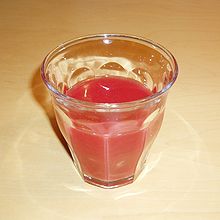| Revision as of 20:15, 15 June 2011 view sourceHertz1888 (talk | contribs)Extended confirmed users, Pending changes reviewers, Rollbackers57,227 editsm →Process: cp word order, etc.← Previous edit | Revision as of 20:15, 15 June 2011 view source Hertz1888 (talk | contribs)Extended confirmed users, Pending changes reviewers, Rollbackers57,227 editsm →Canned orange juice: punct. precedes tagNext edit → | ||
| Line 22: | Line 22: | ||
| ===Canned orange juice=== | ===Canned orange juice=== | ||
| A small fraction of fresh orange juice is ]. Canned orange juice retains ] much better than bottled juice{{Citation needed|date=May 2011}} |
A small fraction of fresh orange juice is ]. Canned orange juice retains ] much better than bottled juice.{{Citation needed|date=May 2011}} However, the canned product loses flavor when stored at room temperature for over 12 weeks.<ref>Yiu H. Hu, József Barta ''Handbook of Fruits and Fruit Processing.'' Blackwell Publishing, 2006. p. 327.</ref> | ||
| ===Major orange juice brands=== | ===Major orange juice brands=== | ||
Revision as of 20:15, 15 June 2011
For other uses, see Orange juice (disambiguation).

Orange juice is a popular beverage made from oranges. It is made by extraction from the fresh fruit, by desiccation and subsequent reconstitution of dried juice, or by concentration of the juice and the subsequent addition of water to the concentrate. The term "orange juice" is also used, both colloquially and commercially, to refer to all of these forms.
Health
| This section needs additional citations for verification. Please help improve this article by adding citations to reliable sources in this section. Unsourced material may be challenged and removed. (Learn how and when to remove this message) |
Citrus juices contain flavonoids that may have health benefits. Orange juice containing pulp seems to be more nutritious than no-pulp varieties due to the flavonoids contained in the pulp. Orange juice is purported to simultaneously cause and aggravate nausea in the popular press, peer-reviewed journal articles, and physicians' opinions. Orange juice is a source of the antioxidant Hesperidin.
Due to the citric acid, orange juice typically has a pH of 3.5. This is similar to the pH of carbonated water and is a cause of erosion of the tooth enamel.
Commercial orange juice and concentrate
Frozen concentrated orange juice
When water is added to freshly thawed concentrated orange juice, it is reconstituted. Most of the orange juice sold today throughout the world is reconstituted juice. Frozen orange juice concentrate is a common drink in the United States.
Process
Squeezed orange juice is pasteurized and filtered before being evaporated under vacuum and heat. After removal of most of the water, this concentrated juice, about 65% sugar by weight, is then stored at about 10 °F (−12 °C). Essences and oils extracted during the vacuum concentration process may be added back to restore flavor. Cans of frozen concentrate are diluted by addition of filtered water bringing the sugar fraction down to 42%, about three times the concentration of fresh juice.
Not from concentrate
Orange juice that has been pasteurized and then sold to consumers without ever having been concentrated is labelled as not-from-concentrate.
Canned orange juice
A small fraction of fresh orange juice is canned. Canned orange juice retains Vitamin C much better than bottled juice. However, the canned product loses flavor when stored at room temperature for over 12 weeks.
Major orange juice brands
In the US, the major orange juice brand is Tropicana Products (owned by PepsiCo Inc.), which possesses nearly 65% of the market share. Tropicana also has a large presence in Latin America, Europe and Central Asia. Competing products include Simply Orange (owned by the Minute Maid division of The Coca-Cola Company) and Florida's Natural (a Florida-based agricultural cooperative that differentiates itself from the competition by using only Florida grown oranges; Tropicana and Simply Orange use a mix of domestic and foreign stock). In Australia, Daily Juice (owned by National Foods) is a major brand of partially fresh partially preserved orange juice. The Original Juice Co. (owned by Golden Circle) produced a fresh no-concentrate (with no preservatives) form of juice marketed as part of their 'Black Label' range of juice products. Both these products, along with other brands are sold in the refrigerated section of supermarkets throughout Australia.
Additives
Some producers add citric acid or ascorbic acid to juice beyond what is naturally found in the orange. Some also include other nutrients such as calcium and Vitamin D, not found naturally in oranges. Low-acid varieties of orange juice are also available. Omega-3 fatty acids are sometimes added to orange juice from fish oils.
Color
Orange juice usually varies between shades of orange and yellow, though some ruby red or blood orange varieties are a reddish-orange or even pinkish. This is due to different pigmentation in ruby red oranges. The name 'orange juice' is thus given to the drink because of the name of the fruit it is made from, rather than the actual color of the juice.
References
- "Acids". British Soft Drinks Association. Archived from the original on 2006-08-26. Retrieved 2006-09-12.
- To prevent off-flavor, distilled or reverse osmosis filtered water should be used when reconstituting frozen juice, devoid of minerals, chlorine, etc.
- Yiu H. Hu, József Barta Handbook of Fruits and Fruit Processing. Blackwell Publishing, 2006. p. 327.
- Statement from National Foods
- New York Times Article on Orange Juice Additives
External links
- Orange juice production Production process and distinction between juice products.
- Brief film clip of orange juice processing from 1968. From the State Library & Archives of Florida.
- Natural orange juice processing Industrial processing of natural orange juice.
- Orange Juice Facts Learn more about orange juice.
| Juice | ||
|---|---|---|
| List of juices | ||
| Fruit juice |  | |
| Vegetable juice | ||
| Animal liquid | ||
| Related | ||